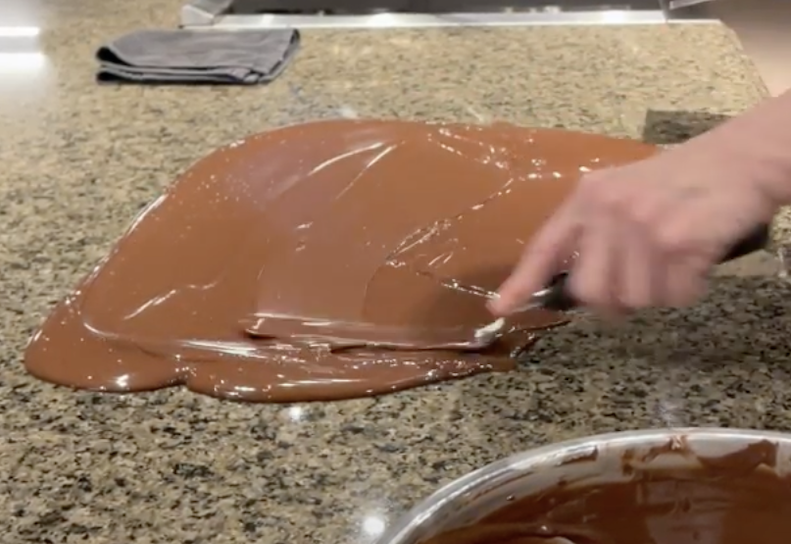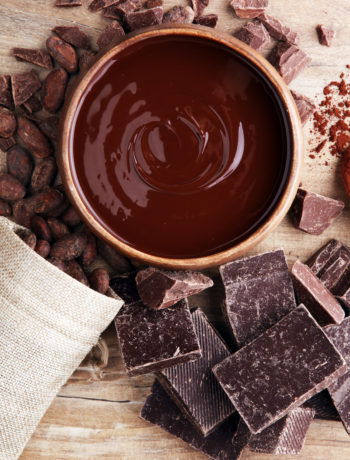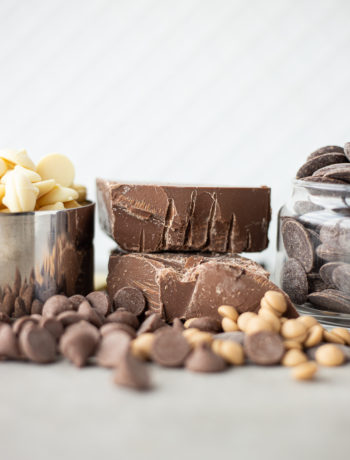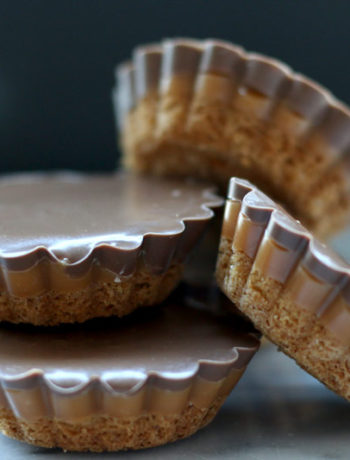The Science of Tempering Chocolate
When it comes to tempering chocolate it’s important to know that all fats, including cocoa butter, are polymorphic, which means that they crystallize into different shapes and forms. In the case of cocoa butter, there are six known crystal forms, I, II, III, IV, V, and VI. Only Form V provides the desirable snap, gloss, and mouthfeel found in tempered chocolate. Its high melting point makes it stable and less likely to melt during storage.
Untempered or improperly tempered chocolate will produce crystals that are unstable at room temperature, meaning that the chocolate may have a dull, spotted or streaked appearance. It may have a soft surface and will bend easily, rather than break with a clean snap.
When chocolate is melted, the cocoa butter crystals melt and the chocolate is no longer in temper. Bringing the chocolate back into temper involves first heating the chocolate, then cooling while agitating the chocolate, all the while observing strict temperatures.
There are several different ways to temper chocolate. One common method introduces Form V crystals in the form of “seeds”. Another common method creates Form V crystals from scratch.
*Seeding Method’
The seeding method uses a small amount of solid tempered chocolate to introduce form V crystals into the melted chocolate. This encourages further formation of form V crystals. The chocolate is cooled simultaneously as the seed chocolate melts. Stirring helps encourage the formation of the crystals. To seed melted chocolate with stable crystals, chop and hold in reserve a portion of solid tempered chocolate. Heat the chocolate to be tempered to 120°F to melt all crystals, and cool it to 95-100°F, just above the temperature range in which stable crystals form. Then stir in the solid portion with its stable crystals, while keeping the temperature in the tempering range, 87-91°F.
*Scratch Method’
Heat the chocolate to 120°F, and cool it down to around 105°F. Then either stir the chocolate as it cools further, until it thickens noticeably (an indication of crystal formation), or pour a portion onto a cool surface, such as marble or granite, and scrape and mix it until it cools and thickens, and then return it to the bowl. Then carefully raise the temperature of the chocolate to the tempering range, 87-90°F, and stir to melt any unstable crystals that might have formed during the stirring or scraping. No matter how chocolate is tempered, its temperature must be held in the temper range until it is used, and while it is being used. If allowed to cool, it will begin to solidify prematurely, won’t flow evenly, and produces an uneven consistency and appearance.

The Art of Chocolate Tempering
An accurate thermometer and careful temperature control are necessary for successful tempering, but they aren’t sufficient. The art of tempering lies in recognizing when the chocolate has accumulated enough stable crystals to form a dense, hard network as it cools. Insufficient tempering time, or insufficient stirring, produces too few stable crystals, resulting in undertempered chocolate, which will form some unstable crystals when it cools, Too much stirring or time produces too many or too large stable crystals and results in overtempered chocolate, which is thick and difficult to work with.
Test for Temper
Place a small, thin coating of chocolate on a room-temperature surface, such as a knife or metal spatula, or piece of foil. Properly tempered chocolate solidifies in a few minutes to a clean, silky-surfaced mass. Chocolate out of temper takes several minutes to harden and has an irregular grainy or streaky appearance.
Working with Tempered Chocolate
The temperature of the tempered chocolate must be maintained while working. This requires attention to detail. Maintain the temperature by re-warming the chocolate with a heat gun, over a double boiler, or other gentle means. Re-warm the chocolate carefully, as it must stay below the upper temperature in the temper range. If the chocolate exceeds the upper temperature, the Form V crystals will melt out, and the chocolate will need to be re-tempered. It is recommended to temper more chocolate than you need, as a greater mass of chocolate in the work bowl will hold its temper longer, extending the work time before re-warming is necessary.
| Flavor | Heat-to-Temperature | Use-at-Temperature |
| Dark | 115°-120° | 89° |
| Milk | 110°-115° | 86° |
| White | 110° | 84° |
Note: the above temperatures are averages. Milk fat, emulsifiers, and other ingredients affect the crystallizing behavior of cocoa butter, which is why milk and white chocolates must be tempered at lower temperatures the dark chocolates.
Each brand of chocolate also has its own ideal tempering pattern. Contact the manufacturer for specific tempering guidelines.
*The information in this article is taken from On Food And Cooking by Harold McGee, and How Baking Works by Paula Figoni





